Business Research Method: Cloud Computing Advantages and Disadvantages
VerifiedAdded on 2020/03/02
|16
|3300
|27
Report
AI Summary
This research proposal examines the multifaceted impact of cloud computing on businesses. It meticulously investigates the advantages, including enhanced flexibility, cost reduction, software updates, increased agility, and scalability, supported by various sources and figures. The report also critically analyzes the disadvantages, such as data stealing, contractual obligations, potential loss of skills, data privacy concerns, and the critical requirement of a reliable internet connection. The literature review incorporates diverse perspectives and identifies gaps in existing research, aiming to provide a comprehensive understanding of cloud computing's role in the modern business environment. The proposal emphasizes the need for a planned approach to mitigate risks associated with cloud adoption and offers insights into the practical implications of these technologies.
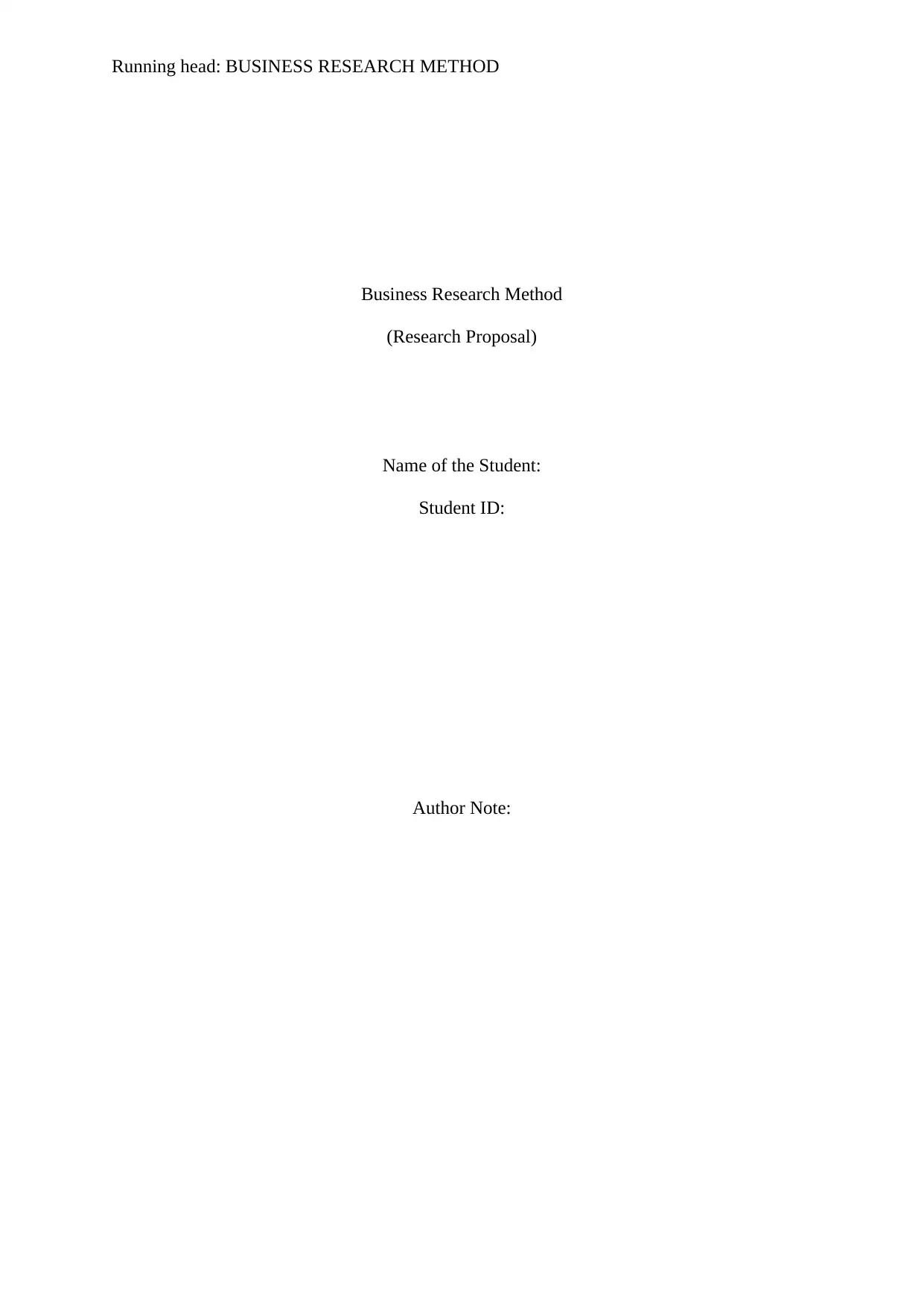
Running head: BUSINESS RESEARCH METHOD
Business Research Method
(Research Proposal)
Name of the Student:
Student ID:
Author Note:
Business Research Method
(Research Proposal)
Name of the Student:
Student ID:
Author Note:
Paraphrase This Document
Need a fresh take? Get an instant paraphrase of this document with our AI Paraphraser
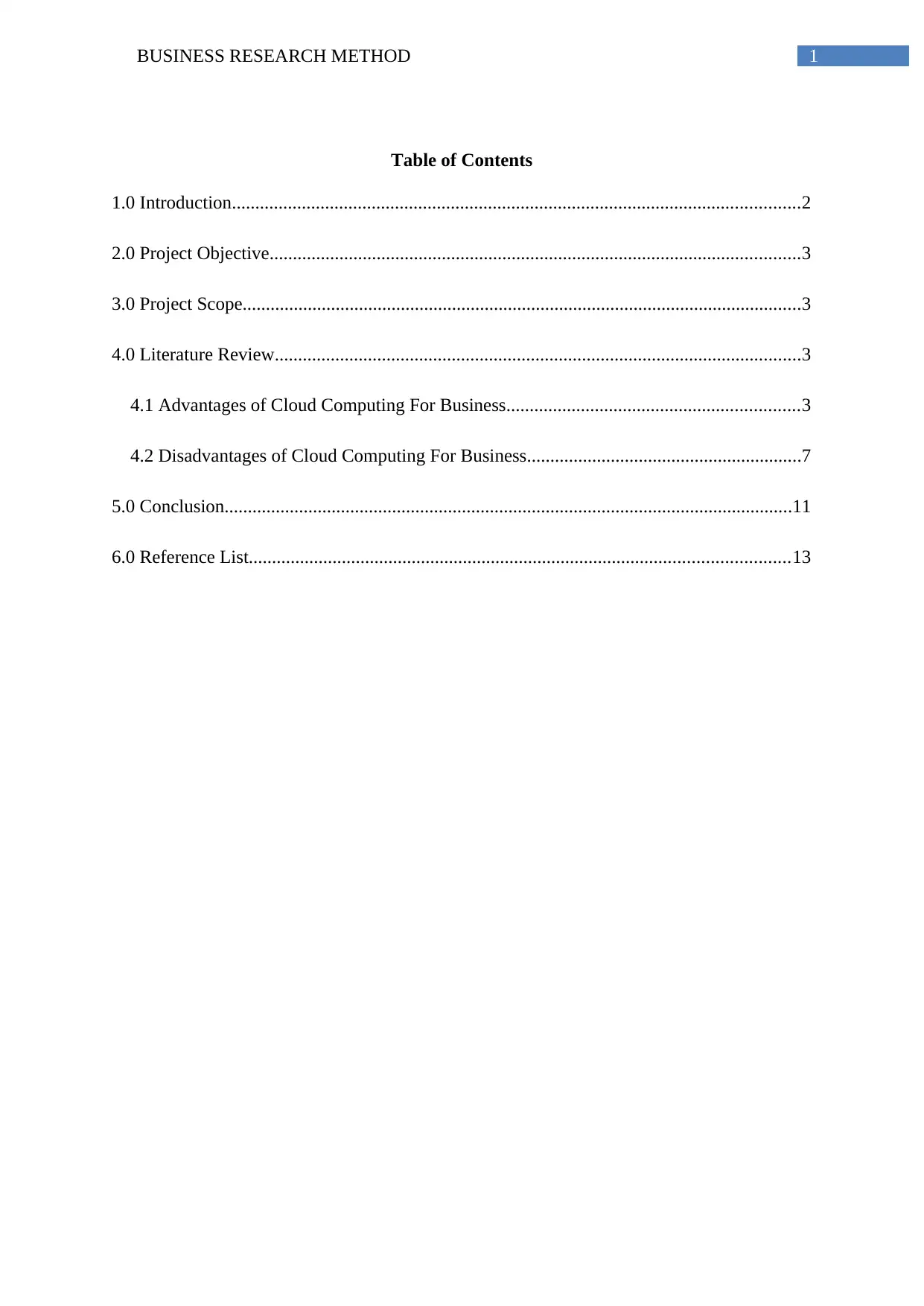
1BUSINESS RESEARCH METHOD
Table of Contents
1.0 Introduction..........................................................................................................................2
2.0 Project Objective..................................................................................................................3
3.0 Project Scope........................................................................................................................3
4.0 Literature Review.................................................................................................................3
4.1 Advantages of Cloud Computing For Business...............................................................3
4.2 Disadvantages of Cloud Computing For Business...........................................................7
5.0 Conclusion..........................................................................................................................11
6.0 Reference List....................................................................................................................13
Table of Contents
1.0 Introduction..........................................................................................................................2
2.0 Project Objective..................................................................................................................3
3.0 Project Scope........................................................................................................................3
4.0 Literature Review.................................................................................................................3
4.1 Advantages of Cloud Computing For Business...............................................................3
4.2 Disadvantages of Cloud Computing For Business...........................................................7
5.0 Conclusion..........................................................................................................................11
6.0 Reference List....................................................................................................................13
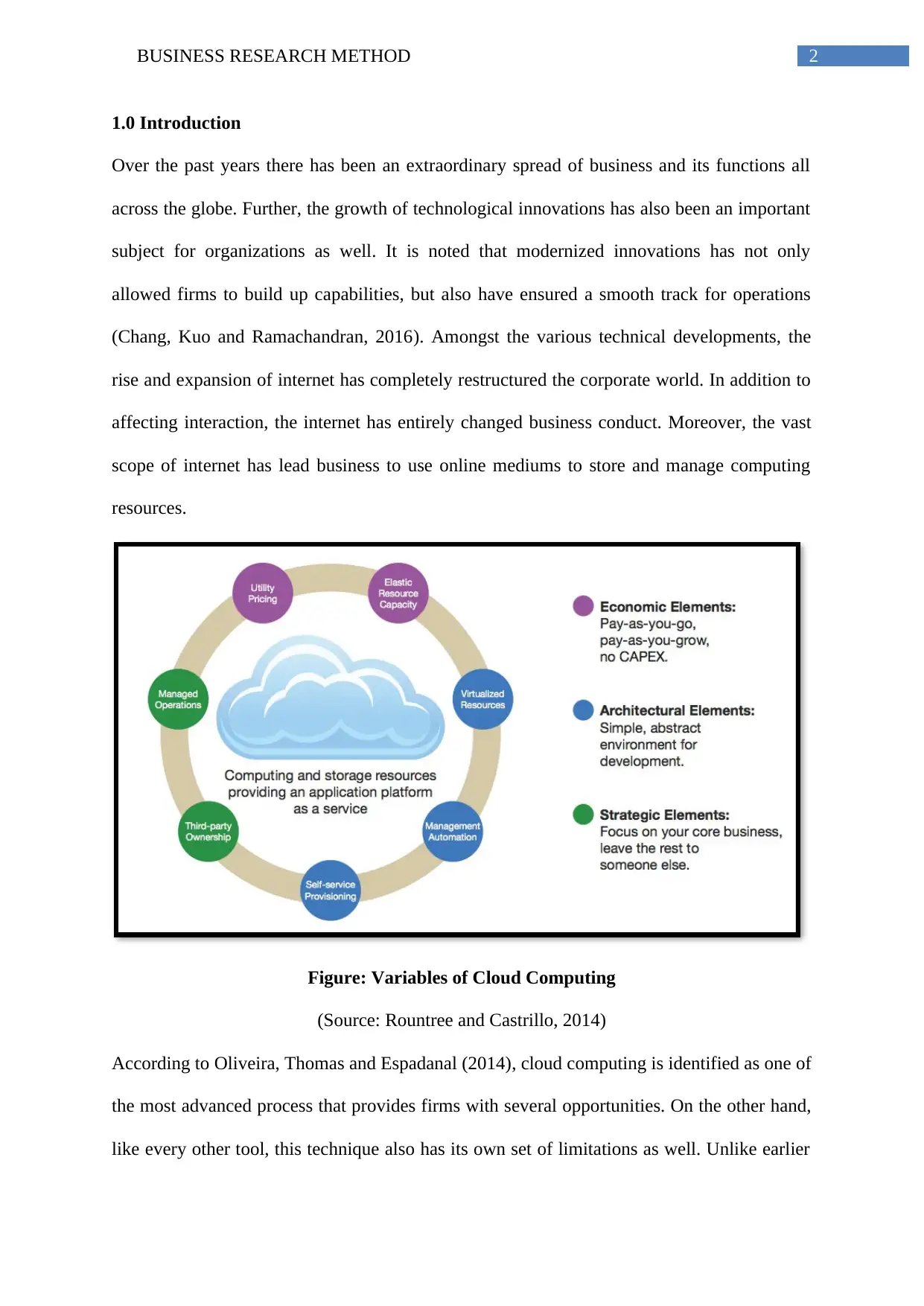
2BUSINESS RESEARCH METHOD
1.0 Introduction
Over the past years there has been an extraordinary spread of business and its functions all
across the globe. Further, the growth of technological innovations has also been an important
subject for organizations as well. It is noted that modernized innovations has not only
allowed firms to build up capabilities, but also have ensured a smooth track for operations
(Chang, Kuo and Ramachandran, 2016). Amongst the various technical developments, the
rise and expansion of internet has completely restructured the corporate world. In addition to
affecting interaction, the internet has entirely changed business conduct. Moreover, the vast
scope of internet has lead business to use online mediums to store and manage computing
resources.
Figure: Variables of Cloud Computing
(Source: Rountree and Castrillo, 2014)
According to Oliveira, Thomas and Espadanal (2014), cloud computing is identified as one of
the most advanced process that provides firms with several opportunities. On the other hand,
like every other tool, this technique also has its own set of limitations as well. Unlike earlier
1.0 Introduction
Over the past years there has been an extraordinary spread of business and its functions all
across the globe. Further, the growth of technological innovations has also been an important
subject for organizations as well. It is noted that modernized innovations has not only
allowed firms to build up capabilities, but also have ensured a smooth track for operations
(Chang, Kuo and Ramachandran, 2016). Amongst the various technical developments, the
rise and expansion of internet has completely restructured the corporate world. In addition to
affecting interaction, the internet has entirely changed business conduct. Moreover, the vast
scope of internet has lead business to use online mediums to store and manage computing
resources.
Figure: Variables of Cloud Computing
(Source: Rountree and Castrillo, 2014)
According to Oliveira, Thomas and Espadanal (2014), cloud computing is identified as one of
the most advanced process that provides firms with several opportunities. On the other hand,
like every other tool, this technique also has its own set of limitations as well. Unlike earlier
⊘ This is a preview!⊘
Do you want full access?
Subscribe today to unlock all pages.

Trusted by 1+ million students worldwide
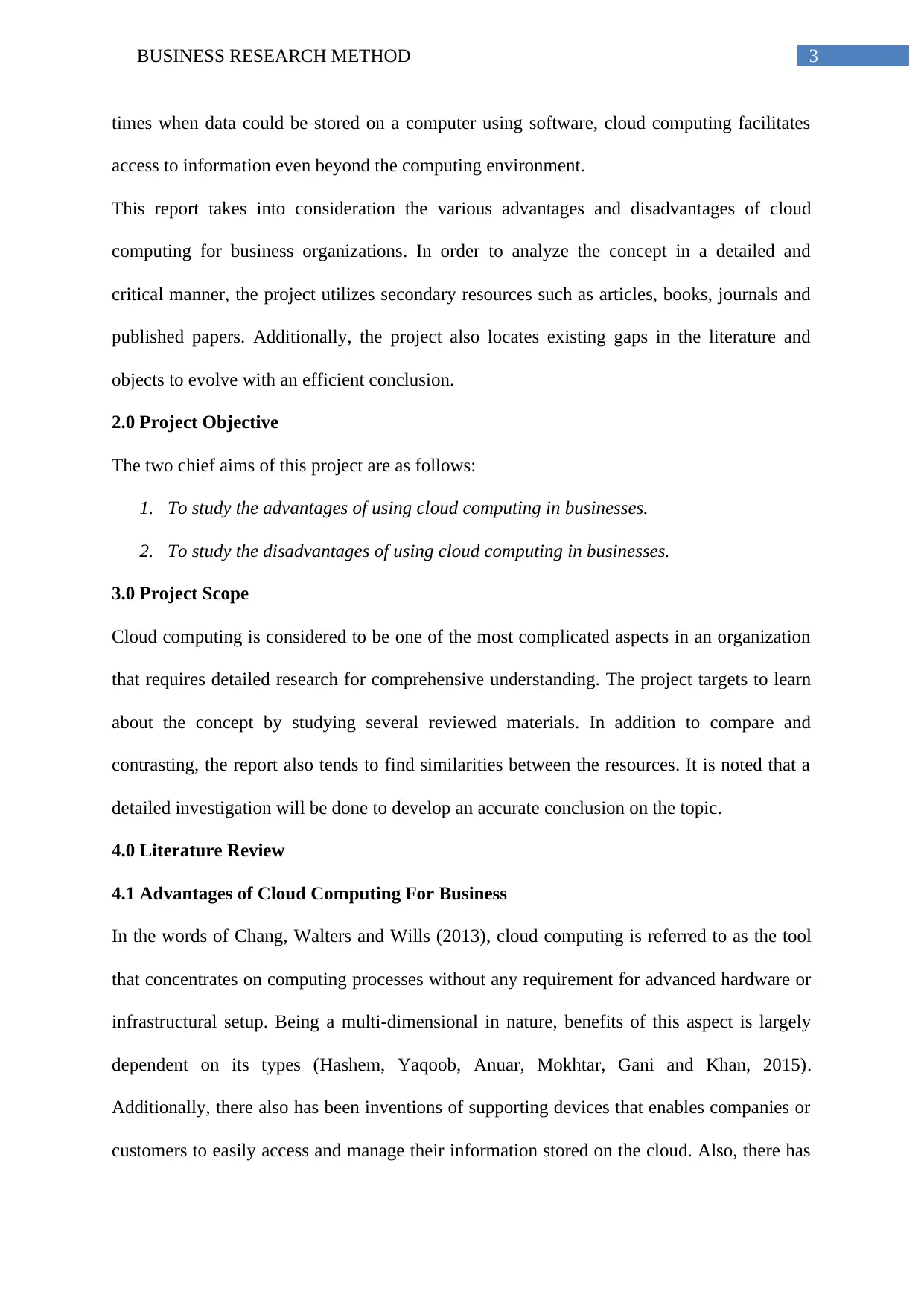
3BUSINESS RESEARCH METHOD
times when data could be stored on a computer using software, cloud computing facilitates
access to information even beyond the computing environment.
This report takes into consideration the various advantages and disadvantages of cloud
computing for business organizations. In order to analyze the concept in a detailed and
critical manner, the project utilizes secondary resources such as articles, books, journals and
published papers. Additionally, the project also locates existing gaps in the literature and
objects to evolve with an efficient conclusion.
2.0 Project Objective
The two chief aims of this project are as follows:
1. To study the advantages of using cloud computing in businesses.
2. To study the disadvantages of using cloud computing in businesses.
3.0 Project Scope
Cloud computing is considered to be one of the most complicated aspects in an organization
that requires detailed research for comprehensive understanding. The project targets to learn
about the concept by studying several reviewed materials. In addition to compare and
contrasting, the report also tends to find similarities between the resources. It is noted that a
detailed investigation will be done to develop an accurate conclusion on the topic.
4.0 Literature Review
4.1 Advantages of Cloud Computing For Business
In the words of Chang, Walters and Wills (2013), cloud computing is referred to as the tool
that concentrates on computing processes without any requirement for advanced hardware or
infrastructural setup. Being a multi-dimensional in nature, benefits of this aspect is largely
dependent on its types (Hashem, Yaqoob, Anuar, Mokhtar, Gani and Khan, 2015).
Additionally, there also has been inventions of supporting devices that enables companies or
customers to easily access and manage their information stored on the cloud. Also, there has
times when data could be stored on a computer using software, cloud computing facilitates
access to information even beyond the computing environment.
This report takes into consideration the various advantages and disadvantages of cloud
computing for business organizations. In order to analyze the concept in a detailed and
critical manner, the project utilizes secondary resources such as articles, books, journals and
published papers. Additionally, the project also locates existing gaps in the literature and
objects to evolve with an efficient conclusion.
2.0 Project Objective
The two chief aims of this project are as follows:
1. To study the advantages of using cloud computing in businesses.
2. To study the disadvantages of using cloud computing in businesses.
3.0 Project Scope
Cloud computing is considered to be one of the most complicated aspects in an organization
that requires detailed research for comprehensive understanding. The project targets to learn
about the concept by studying several reviewed materials. In addition to compare and
contrasting, the report also tends to find similarities between the resources. It is noted that a
detailed investigation will be done to develop an accurate conclusion on the topic.
4.0 Literature Review
4.1 Advantages of Cloud Computing For Business
In the words of Chang, Walters and Wills (2013), cloud computing is referred to as the tool
that concentrates on computing processes without any requirement for advanced hardware or
infrastructural setup. Being a multi-dimensional in nature, benefits of this aspect is largely
dependent on its types (Hashem, Yaqoob, Anuar, Mokhtar, Gani and Khan, 2015).
Additionally, there also has been inventions of supporting devices that enables companies or
customers to easily access and manage their information stored on the cloud. Also, there has
Paraphrase This Document
Need a fresh take? Get an instant paraphrase of this document with our AI Paraphraser
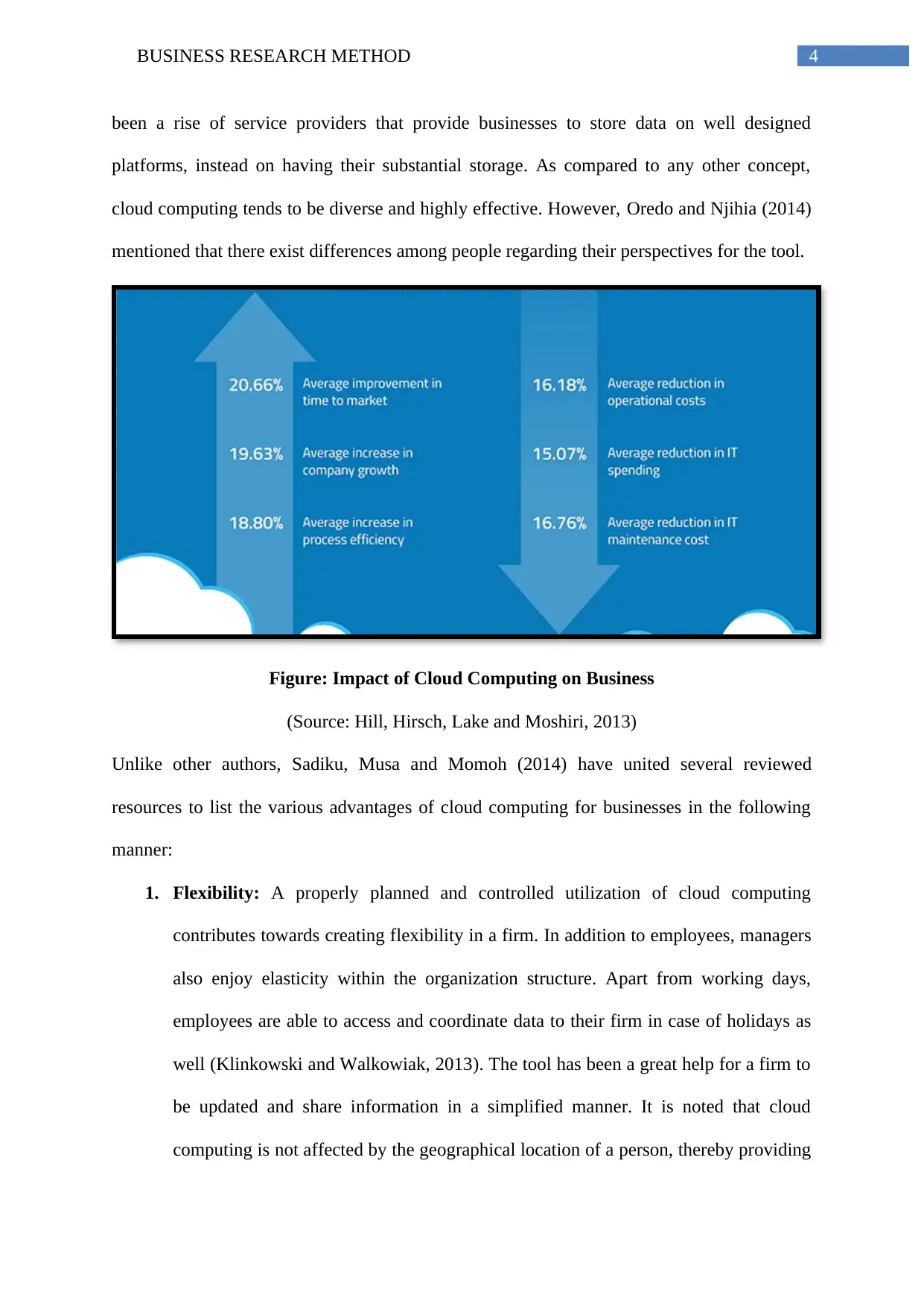
4BUSINESS RESEARCH METHOD
been a rise of service providers that provide businesses to store data on well designed
platforms, instead on having their substantial storage. As compared to any other concept,
cloud computing tends to be diverse and highly effective. However, Oredo and Njihia (2014)
mentioned that there exist differences among people regarding their perspectives for the tool.
Figure: Impact of Cloud Computing on Business
(Source: Hill, Hirsch, Lake and Moshiri, 2013)
Unlike other authors, Sadiku, Musa and Momoh (2014) have united several reviewed
resources to list the various advantages of cloud computing for businesses in the following
manner:
1. Flexibility: A properly planned and controlled utilization of cloud computing
contributes towards creating flexibility in a firm. In addition to employees, managers
also enjoy elasticity within the organization structure. Apart from working days,
employees are able to access and coordinate data to their firm in case of holidays as
well (Klinkowski and Walkowiak, 2013). The tool has been a great help for a firm to
be updated and share information in a simplified manner. It is noted that cloud
computing is not affected by the geographical location of a person, thereby providing
been a rise of service providers that provide businesses to store data on well designed
platforms, instead on having their substantial storage. As compared to any other concept,
cloud computing tends to be diverse and highly effective. However, Oredo and Njihia (2014)
mentioned that there exist differences among people regarding their perspectives for the tool.
Figure: Impact of Cloud Computing on Business
(Source: Hill, Hirsch, Lake and Moshiri, 2013)
Unlike other authors, Sadiku, Musa and Momoh (2014) have united several reviewed
resources to list the various advantages of cloud computing for businesses in the following
manner:
1. Flexibility: A properly planned and controlled utilization of cloud computing
contributes towards creating flexibility in a firm. In addition to employees, managers
also enjoy elasticity within the organization structure. Apart from working days,
employees are able to access and coordinate data to their firm in case of holidays as
well (Klinkowski and Walkowiak, 2013). The tool has been a great help for a firm to
be updated and share information in a simplified manner. It is noted that cloud
computing is not affected by the geographical location of a person, thereby providing
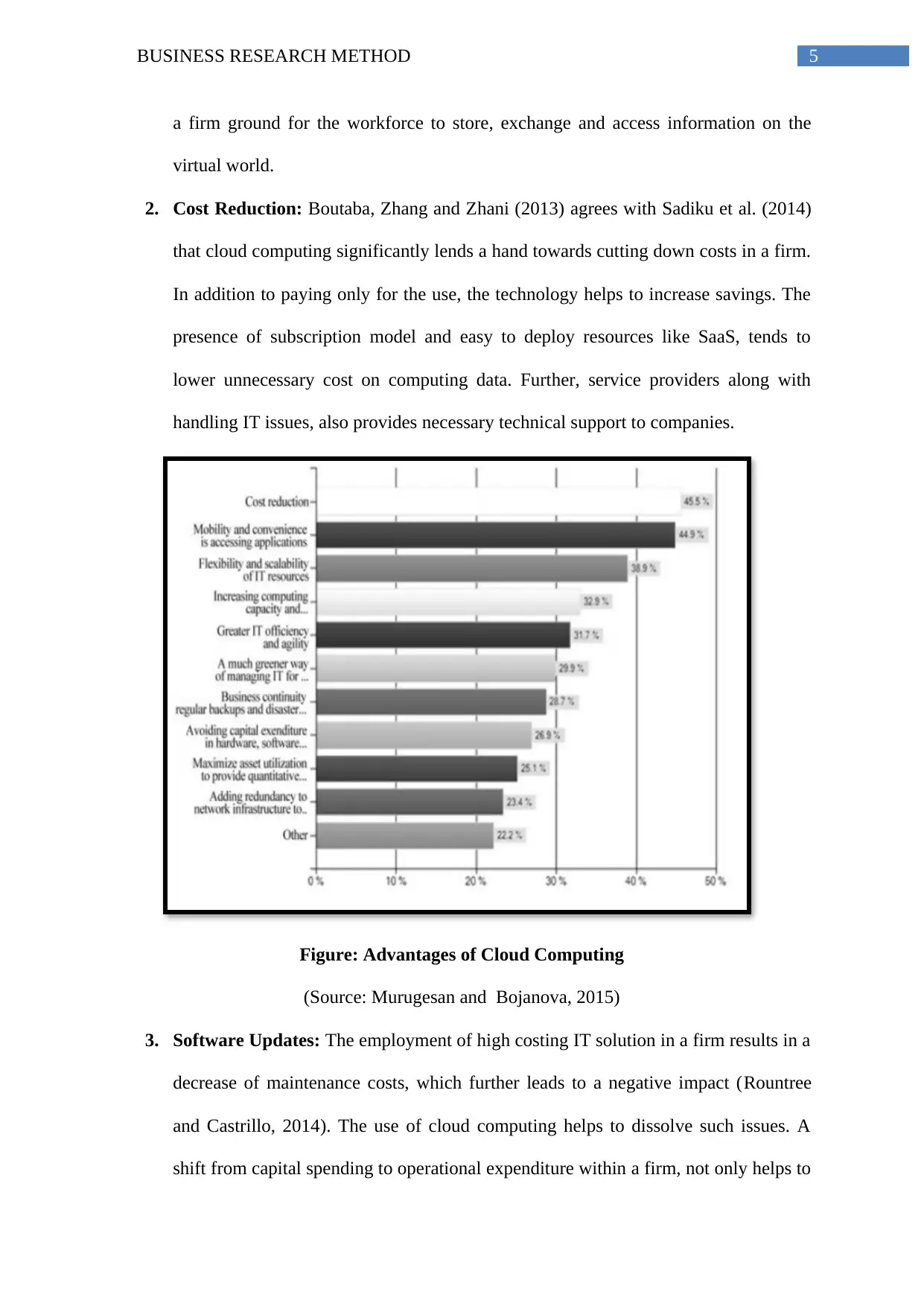
5BUSINESS RESEARCH METHOD
a firm ground for the workforce to store, exchange and access information on the
virtual world.
2. Cost Reduction: Boutaba, Zhang and Zhani (2013) agrees with Sadiku et al. (2014)
that cloud computing significantly lends a hand towards cutting down costs in a firm.
In addition to paying only for the use, the technology helps to increase savings. The
presence of subscription model and easy to deploy resources like SaaS, tends to
lower unnecessary cost on computing data. Further, service providers along with
handling IT issues, also provides necessary technical support to companies.
Figure: Advantages of Cloud Computing
(Source: Murugesan and Bojanova, 2015)
3. Software Updates: The employment of high costing IT solution in a firm results in a
decrease of maintenance costs, which further leads to a negative impact (Rountree
and Castrillo, 2014). The use of cloud computing helps to dissolve such issues. A
shift from capital spending to operational expenditure within a firm, not only helps to
a firm ground for the workforce to store, exchange and access information on the
virtual world.
2. Cost Reduction: Boutaba, Zhang and Zhani (2013) agrees with Sadiku et al. (2014)
that cloud computing significantly lends a hand towards cutting down costs in a firm.
In addition to paying only for the use, the technology helps to increase savings. The
presence of subscription model and easy to deploy resources like SaaS, tends to
lower unnecessary cost on computing data. Further, service providers along with
handling IT issues, also provides necessary technical support to companies.
Figure: Advantages of Cloud Computing
(Source: Murugesan and Bojanova, 2015)
3. Software Updates: The employment of high costing IT solution in a firm results in a
decrease of maintenance costs, which further leads to a negative impact (Rountree
and Castrillo, 2014). The use of cloud computing helps to dissolve such issues. A
shift from capital spending to operational expenditure within a firm, not only helps to
⊘ This is a preview!⊘
Do you want full access?
Subscribe today to unlock all pages.

Trusted by 1+ million students worldwide
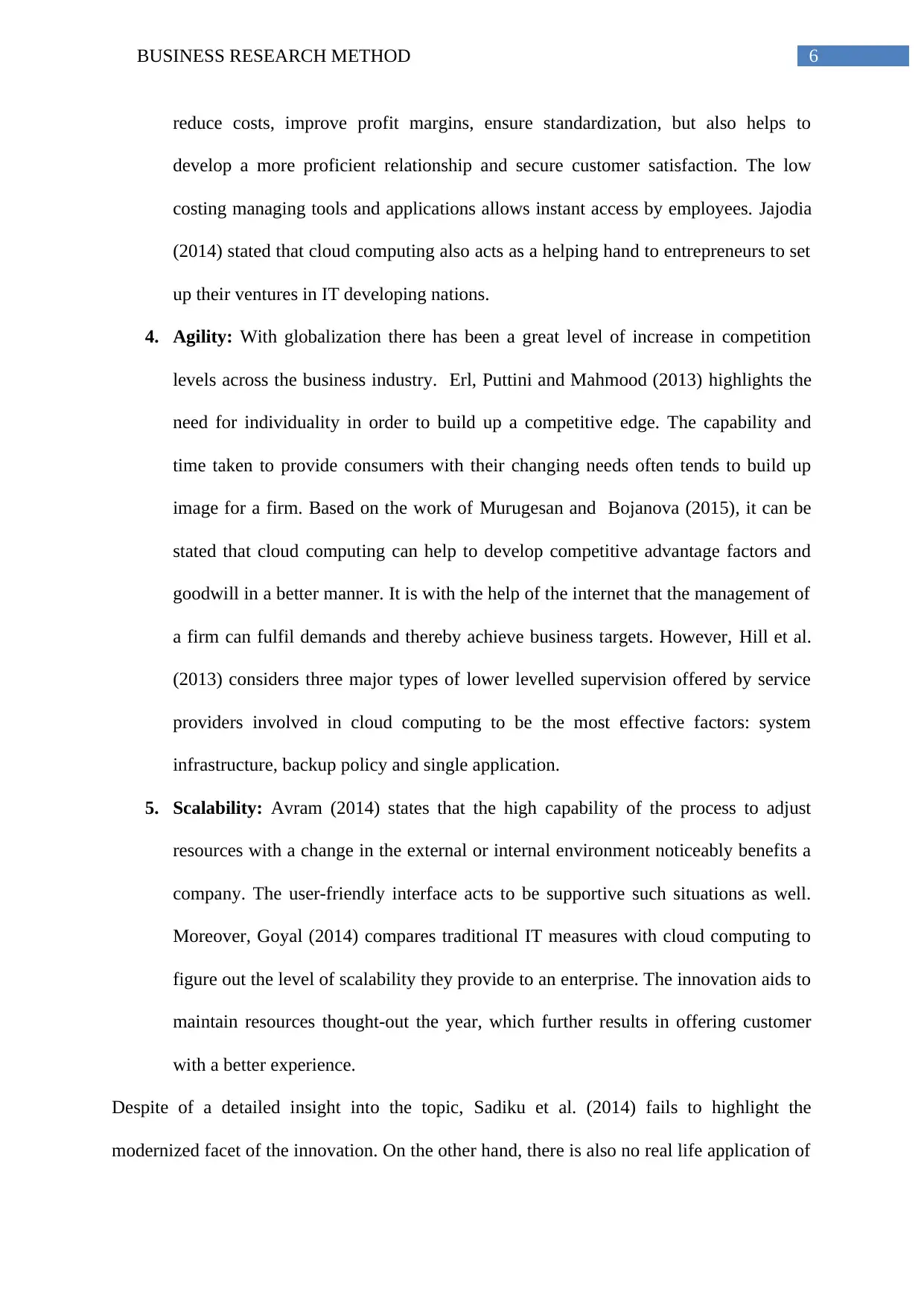
6BUSINESS RESEARCH METHOD
reduce costs, improve profit margins, ensure standardization, but also helps to
develop a more proficient relationship and secure customer satisfaction. The low
costing managing tools and applications allows instant access by employees. Jajodia
(2014) stated that cloud computing also acts as a helping hand to entrepreneurs to set
up their ventures in IT developing nations.
4. Agility: With globalization there has been a great level of increase in competition
levels across the business industry. Erl, Puttini and Mahmood (2013) highlights the
need for individuality in order to build up a competitive edge. The capability and
time taken to provide consumers with their changing needs often tends to build up
image for a firm. Based on the work of Murugesan and Bojanova (2015), it can be
stated that cloud computing can help to develop competitive advantage factors and
goodwill in a better manner. It is with the help of the internet that the management of
a firm can fulfil demands and thereby achieve business targets. However, Hill et al.
(2013) considers three major types of lower levelled supervision offered by service
providers involved in cloud computing to be the most effective factors: system
infrastructure, backup policy and single application.
5. Scalability: Avram (2014) states that the high capability of the process to adjust
resources with a change in the external or internal environment noticeably benefits a
company. The user-friendly interface acts to be supportive such situations as well.
Moreover, Goyal (2014) compares traditional IT measures with cloud computing to
figure out the level of scalability they provide to an enterprise. The innovation aids to
maintain resources thought-out the year, which further results in offering customer
with a better experience.
Despite of a detailed insight into the topic, Sadiku et al. (2014) fails to highlight the
modernized facet of the innovation. On the other hand, there is also no real life application of
reduce costs, improve profit margins, ensure standardization, but also helps to
develop a more proficient relationship and secure customer satisfaction. The low
costing managing tools and applications allows instant access by employees. Jajodia
(2014) stated that cloud computing also acts as a helping hand to entrepreneurs to set
up their ventures in IT developing nations.
4. Agility: With globalization there has been a great level of increase in competition
levels across the business industry. Erl, Puttini and Mahmood (2013) highlights the
need for individuality in order to build up a competitive edge. The capability and
time taken to provide consumers with their changing needs often tends to build up
image for a firm. Based on the work of Murugesan and Bojanova (2015), it can be
stated that cloud computing can help to develop competitive advantage factors and
goodwill in a better manner. It is with the help of the internet that the management of
a firm can fulfil demands and thereby achieve business targets. However, Hill et al.
(2013) considers three major types of lower levelled supervision offered by service
providers involved in cloud computing to be the most effective factors: system
infrastructure, backup policy and single application.
5. Scalability: Avram (2014) states that the high capability of the process to adjust
resources with a change in the external or internal environment noticeably benefits a
company. The user-friendly interface acts to be supportive such situations as well.
Moreover, Goyal (2014) compares traditional IT measures with cloud computing to
figure out the level of scalability they provide to an enterprise. The innovation aids to
maintain resources thought-out the year, which further results in offering customer
with a better experience.
Despite of a detailed insight into the topic, Sadiku et al. (2014) fails to highlight the
modernized facet of the innovation. On the other hand, there is also no real life application of
Paraphrase This Document
Need a fresh take? Get an instant paraphrase of this document with our AI Paraphraser
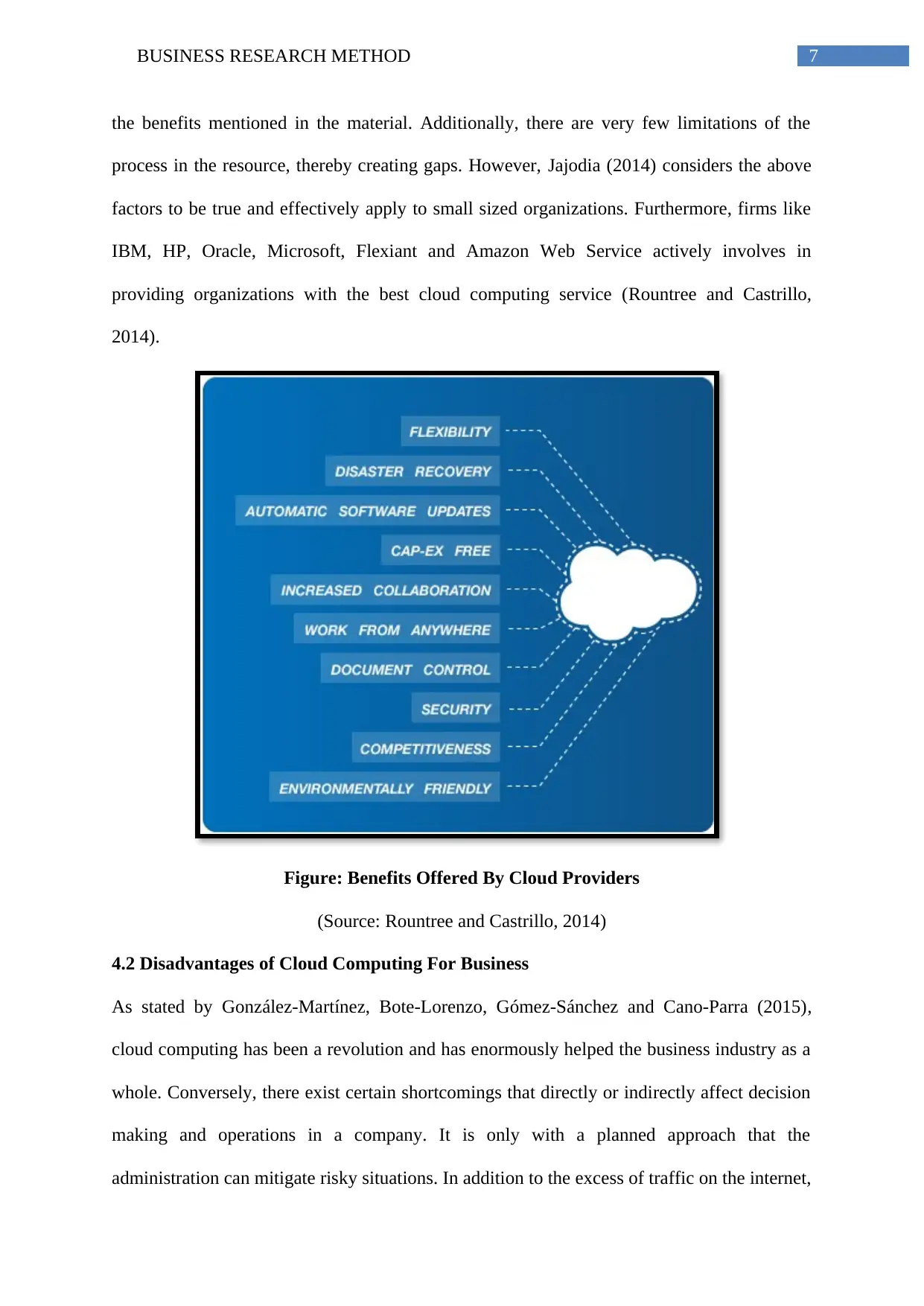
7BUSINESS RESEARCH METHOD
the benefits mentioned in the material. Additionally, there are very few limitations of the
process in the resource, thereby creating gaps. However, Jajodia (2014) considers the above
factors to be true and effectively apply to small sized organizations. Furthermore, firms like
IBM, HP, Oracle, Microsoft, Flexiant and Amazon Web Service actively involves in
providing organizations with the best cloud computing service (Rountree and Castrillo,
2014).
Figure: Benefits Offered By Cloud Providers
(Source: Rountree and Castrillo, 2014)
4.2 Disadvantages of Cloud Computing For Business
As stated by González-Martínez, Bote-Lorenzo, Gómez-Sánchez and Cano-Parra (2015),
cloud computing has been a revolution and has enormously helped the business industry as a
whole. Conversely, there exist certain shortcomings that directly or indirectly affect decision
making and operations in a company. It is only with a planned approach that the
administration can mitigate risky situations. In addition to the excess of traffic on the internet,
the benefits mentioned in the material. Additionally, there are very few limitations of the
process in the resource, thereby creating gaps. However, Jajodia (2014) considers the above
factors to be true and effectively apply to small sized organizations. Furthermore, firms like
IBM, HP, Oracle, Microsoft, Flexiant and Amazon Web Service actively involves in
providing organizations with the best cloud computing service (Rountree and Castrillo,
2014).
Figure: Benefits Offered By Cloud Providers
(Source: Rountree and Castrillo, 2014)
4.2 Disadvantages of Cloud Computing For Business
As stated by González-Martínez, Bote-Lorenzo, Gómez-Sánchez and Cano-Parra (2015),
cloud computing has been a revolution and has enormously helped the business industry as a
whole. Conversely, there exist certain shortcomings that directly or indirectly affect decision
making and operations in a company. It is only with a planned approach that the
administration can mitigate risky situations. In addition to the excess of traffic on the internet,
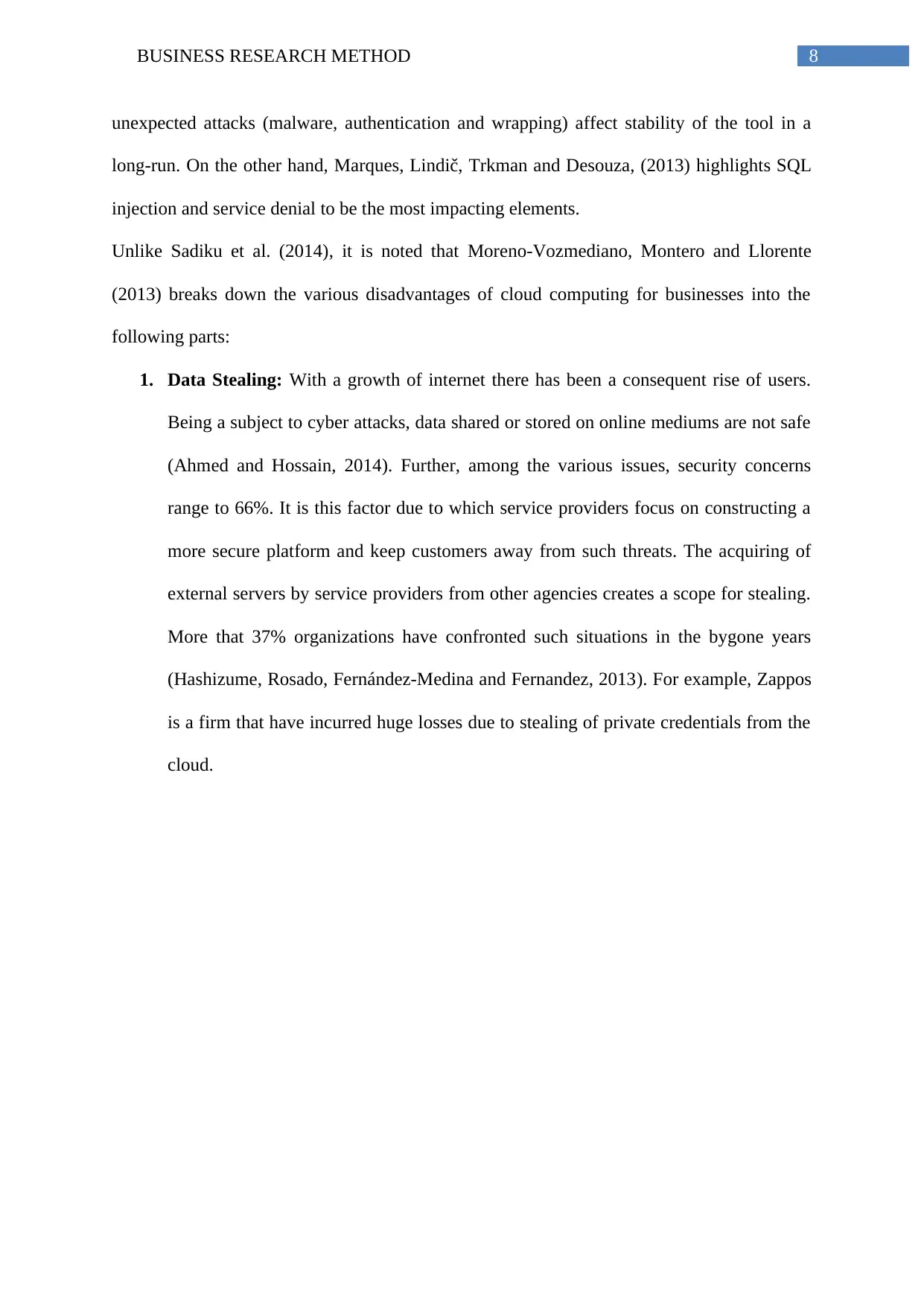
8BUSINESS RESEARCH METHOD
unexpected attacks (malware, authentication and wrapping) affect stability of the tool in a
long-run. On the other hand, Marques, Lindič, Trkman and Desouza, (2013) highlights SQL
injection and service denial to be the most impacting elements.
Unlike Sadiku et al. (2014), it is noted that Moreno-Vozmediano, Montero and Llorente
(2013) breaks down the various disadvantages of cloud computing for businesses into the
following parts:
1. Data Stealing: With a growth of internet there has been a consequent rise of users.
Being a subject to cyber attacks, data shared or stored on online mediums are not safe
(Ahmed and Hossain, 2014). Further, among the various issues, security concerns
range to 66%. It is this factor due to which service providers focus on constructing a
more secure platform and keep customers away from such threats. The acquiring of
external servers by service providers from other agencies creates a scope for stealing.
More that 37% organizations have confronted such situations in the bygone years
(Hashizume, Rosado, Fernández-Medina and Fernandez, 2013). For example, Zappos
is a firm that have incurred huge losses due to stealing of private credentials from the
cloud.
unexpected attacks (malware, authentication and wrapping) affect stability of the tool in a
long-run. On the other hand, Marques, Lindič, Trkman and Desouza, (2013) highlights SQL
injection and service denial to be the most impacting elements.
Unlike Sadiku et al. (2014), it is noted that Moreno-Vozmediano, Montero and Llorente
(2013) breaks down the various disadvantages of cloud computing for businesses into the
following parts:
1. Data Stealing: With a growth of internet there has been a consequent rise of users.
Being a subject to cyber attacks, data shared or stored on online mediums are not safe
(Ahmed and Hossain, 2014). Further, among the various issues, security concerns
range to 66%. It is this factor due to which service providers focus on constructing a
more secure platform and keep customers away from such threats. The acquiring of
external servers by service providers from other agencies creates a scope for stealing.
More that 37% organizations have confronted such situations in the bygone years
(Hashizume, Rosado, Fernández-Medina and Fernandez, 2013). For example, Zappos
is a firm that have incurred huge losses due to stealing of private credentials from the
cloud.
⊘ This is a preview!⊘
Do you want full access?
Subscribe today to unlock all pages.

Trusted by 1+ million students worldwide
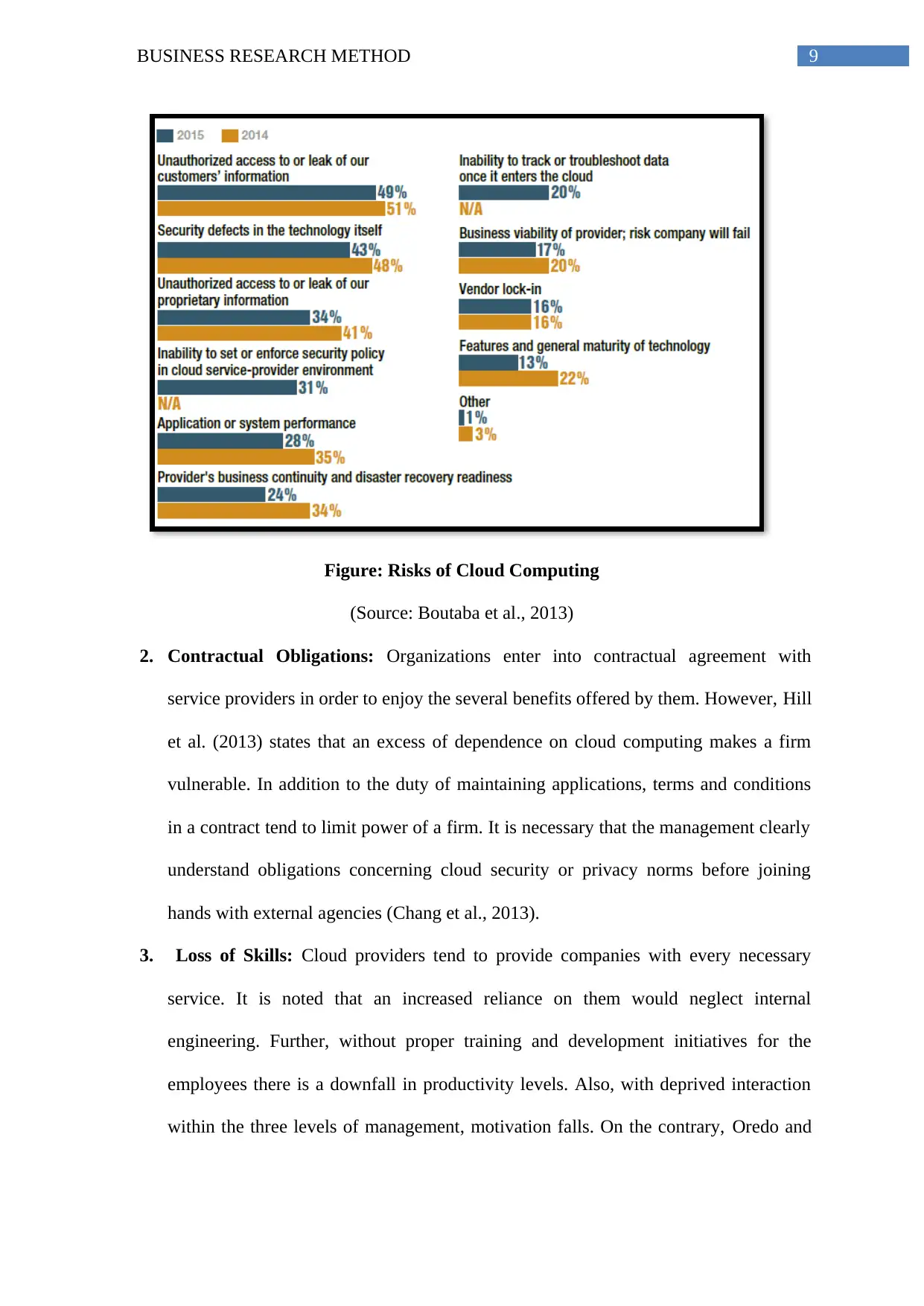
9BUSINESS RESEARCH METHOD
Figure: Risks of Cloud Computing
(Source: Boutaba et al., 2013)
2. Contractual Obligations: Organizations enter into contractual agreement with
service providers in order to enjoy the several benefits offered by them. However, Hill
et al. (2013) states that an excess of dependence on cloud computing makes a firm
vulnerable. In addition to the duty of maintaining applications, terms and conditions
in a contract tend to limit power of a firm. It is necessary that the management clearly
understand obligations concerning cloud security or privacy norms before joining
hands with external agencies (Chang et al., 2013).
3. Loss of Skills: Cloud providers tend to provide companies with every necessary
service. It is noted that an increased reliance on them would neglect internal
engineering. Further, without proper training and development initiatives for the
employees there is a downfall in productivity levels. Also, with deprived interaction
within the three levels of management, motivation falls. On the contrary, Oredo and
Figure: Risks of Cloud Computing
(Source: Boutaba et al., 2013)
2. Contractual Obligations: Organizations enter into contractual agreement with
service providers in order to enjoy the several benefits offered by them. However, Hill
et al. (2013) states that an excess of dependence on cloud computing makes a firm
vulnerable. In addition to the duty of maintaining applications, terms and conditions
in a contract tend to limit power of a firm. It is necessary that the management clearly
understand obligations concerning cloud security or privacy norms before joining
hands with external agencies (Chang et al., 2013).
3. Loss of Skills: Cloud providers tend to provide companies with every necessary
service. It is noted that an increased reliance on them would neglect internal
engineering. Further, without proper training and development initiatives for the
employees there is a downfall in productivity levels. Also, with deprived interaction
within the three levels of management, motivation falls. On the contrary, Oredo and
Paraphrase This Document
Need a fresh take? Get an instant paraphrase of this document with our AI Paraphraser
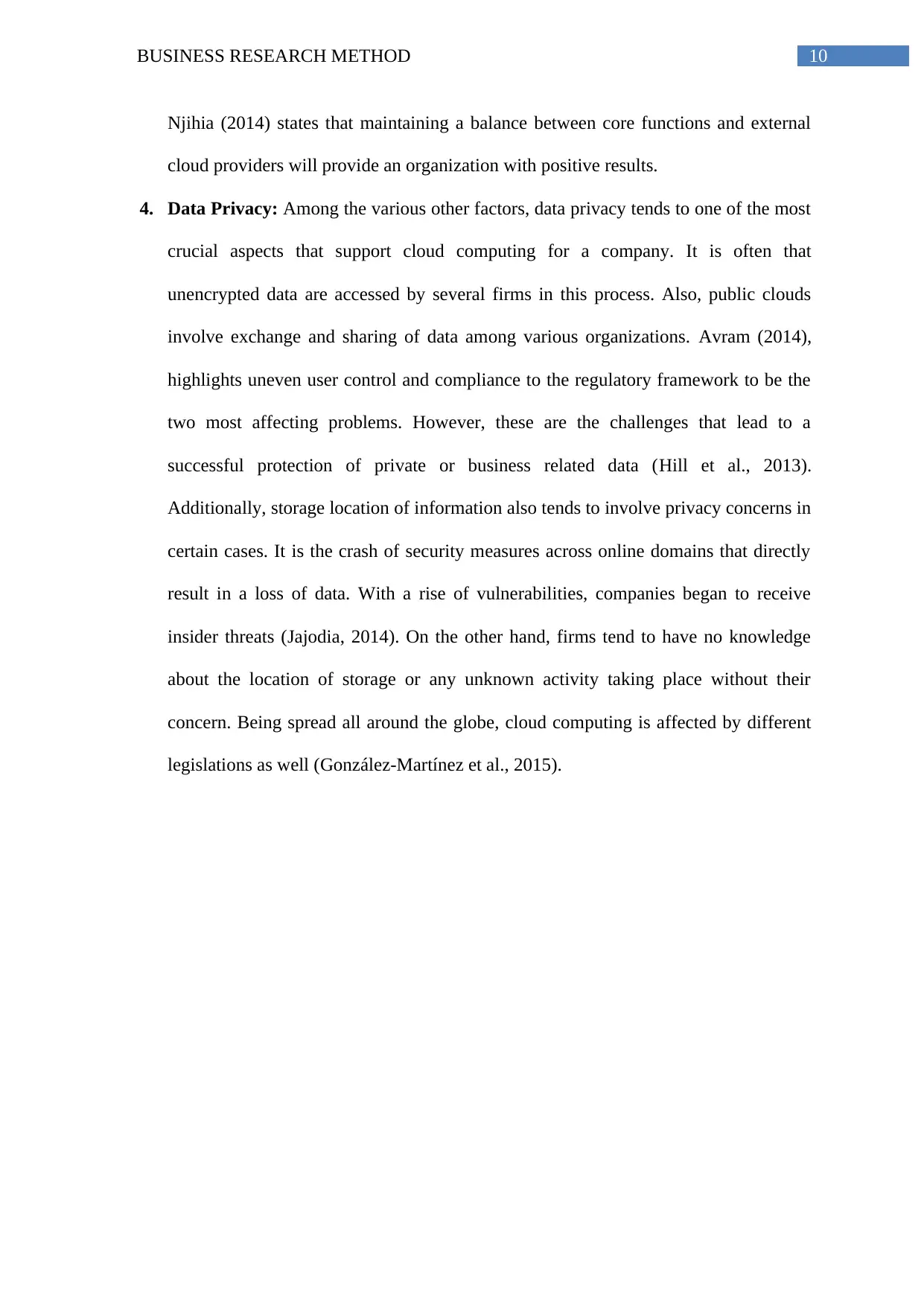
10BUSINESS RESEARCH METHOD
Njihia (2014) states that maintaining a balance between core functions and external
cloud providers will provide an organization with positive results.
4. Data Privacy: Among the various other factors, data privacy tends to one of the most
crucial aspects that support cloud computing for a company. It is often that
unencrypted data are accessed by several firms in this process. Also, public clouds
involve exchange and sharing of data among various organizations. Avram (2014),
highlights uneven user control and compliance to the regulatory framework to be the
two most affecting problems. However, these are the challenges that lead to a
successful protection of private or business related data (Hill et al., 2013).
Additionally, storage location of information also tends to involve privacy concerns in
certain cases. It is the crash of security measures across online domains that directly
result in a loss of data. With a rise of vulnerabilities, companies began to receive
insider threats (Jajodia, 2014). On the other hand, firms tend to have no knowledge
about the location of storage or any unknown activity taking place without their
concern. Being spread all around the globe, cloud computing is affected by different
legislations as well (González-Martínez et al., 2015).
Njihia (2014) states that maintaining a balance between core functions and external
cloud providers will provide an organization with positive results.
4. Data Privacy: Among the various other factors, data privacy tends to one of the most
crucial aspects that support cloud computing for a company. It is often that
unencrypted data are accessed by several firms in this process. Also, public clouds
involve exchange and sharing of data among various organizations. Avram (2014),
highlights uneven user control and compliance to the regulatory framework to be the
two most affecting problems. However, these are the challenges that lead to a
successful protection of private or business related data (Hill et al., 2013).
Additionally, storage location of information also tends to involve privacy concerns in
certain cases. It is the crash of security measures across online domains that directly
result in a loss of data. With a rise of vulnerabilities, companies began to receive
insider threats (Jajodia, 2014). On the other hand, firms tend to have no knowledge
about the location of storage or any unknown activity taking place without their
concern. Being spread all around the globe, cloud computing is affected by different
legislations as well (González-Martínez et al., 2015).
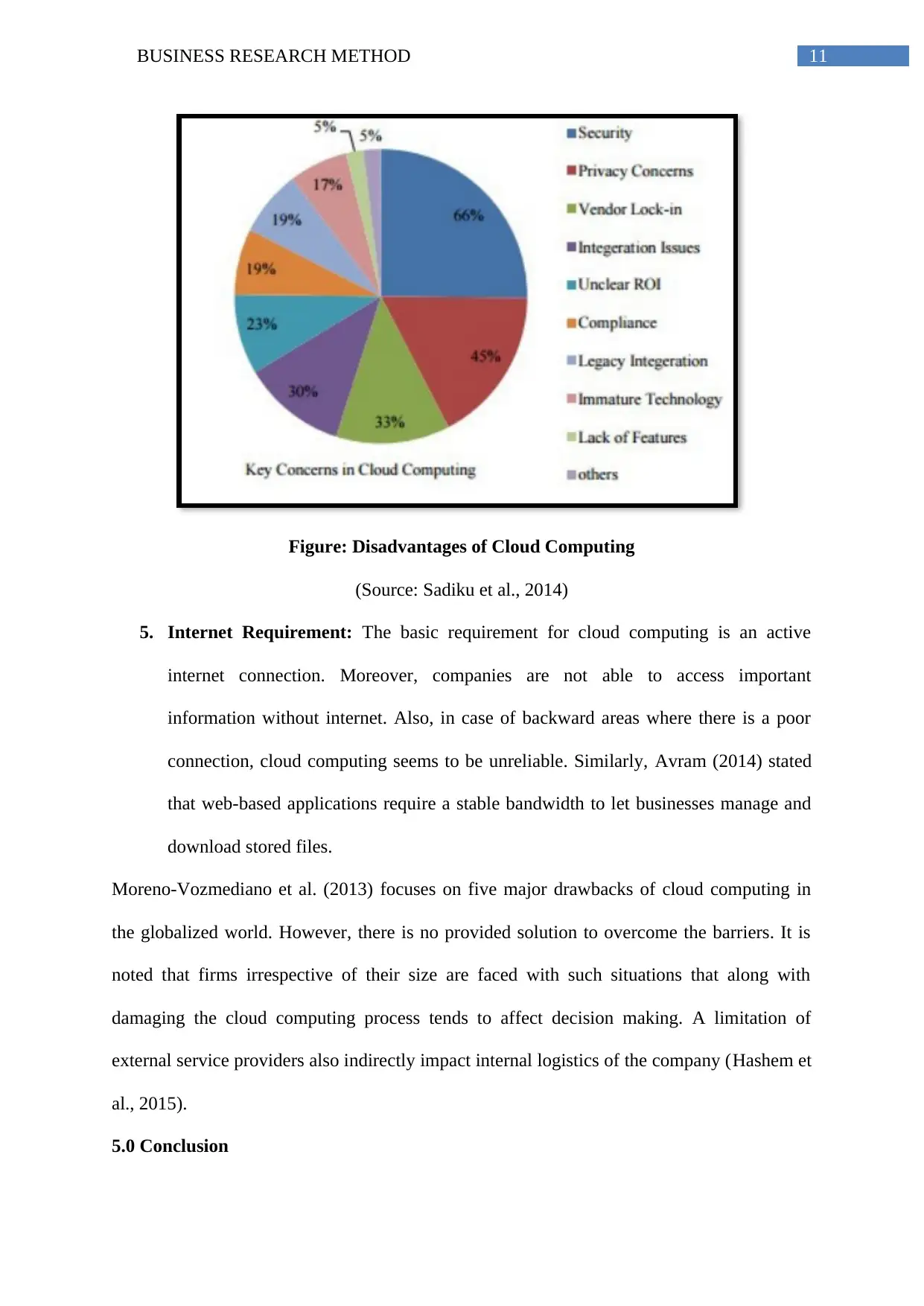
11BUSINESS RESEARCH METHOD
Figure: Disadvantages of Cloud Computing
(Source: Sadiku et al., 2014)
5. Internet Requirement: The basic requirement for cloud computing is an active
internet connection. Moreover, companies are not able to access important
information without internet. Also, in case of backward areas where there is a poor
connection, cloud computing seems to be unreliable. Similarly, Avram (2014) stated
that web-based applications require a stable bandwidth to let businesses manage and
download stored files.
Moreno-Vozmediano et al. (2013) focuses on five major drawbacks of cloud computing in
the globalized world. However, there is no provided solution to overcome the barriers. It is
noted that firms irrespective of their size are faced with such situations that along with
damaging the cloud computing process tends to affect decision making. A limitation of
external service providers also indirectly impact internal logistics of the company (Hashem et
al., 2015).
5.0 Conclusion
Figure: Disadvantages of Cloud Computing
(Source: Sadiku et al., 2014)
5. Internet Requirement: The basic requirement for cloud computing is an active
internet connection. Moreover, companies are not able to access important
information without internet. Also, in case of backward areas where there is a poor
connection, cloud computing seems to be unreliable. Similarly, Avram (2014) stated
that web-based applications require a stable bandwidth to let businesses manage and
download stored files.
Moreno-Vozmediano et al. (2013) focuses on five major drawbacks of cloud computing in
the globalized world. However, there is no provided solution to overcome the barriers. It is
noted that firms irrespective of their size are faced with such situations that along with
damaging the cloud computing process tends to affect decision making. A limitation of
external service providers also indirectly impact internal logistics of the company (Hashem et
al., 2015).
5.0 Conclusion
⊘ This is a preview!⊘
Do you want full access?
Subscribe today to unlock all pages.

Trusted by 1+ million students worldwide
1 out of 16
Related Documents
Your All-in-One AI-Powered Toolkit for Academic Success.
+13062052269
info@desklib.com
Available 24*7 on WhatsApp / Email
![[object Object]](/_next/static/media/star-bottom.7253800d.svg)
Unlock your academic potential
Copyright © 2020–2025 A2Z Services. All Rights Reserved. Developed and managed by ZUCOL.





